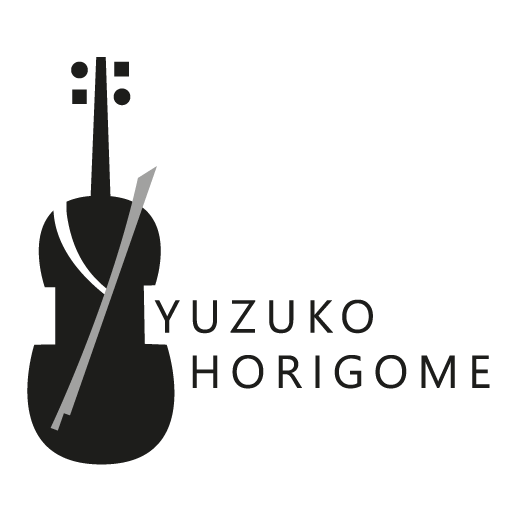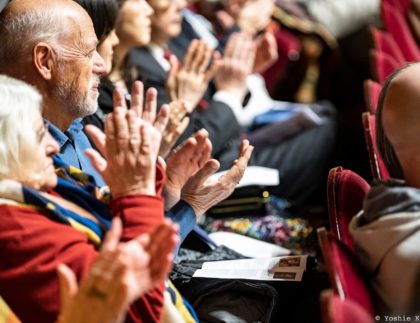Even Brahms and Mozart transcribed what was in their mind.
We see and hear those transcriptions as their masterpieces, and perform them.
Left-hand fingerings were created so that violinists could perform these pieces. We practice
the scales, arpeggios, and chords pertaining to such pieces.
Whenever I didn’t understand a Bach Fugue, I often dictated the piece from memory onto
manuscript paper.
In that process I would realize how little of the piece I had actually memorized.
I never imagined that I would transcribe Brahms’ violin concerto.
Ms. Keiko Wataya suddenly came into my life. She was my late sister Momoko’s senior
colleague when Momoko was studying in the Mozarteum.
Keiko is an accomplished violin teacher and has taught all over Europe, including in
Utrecht, Amsterdam, Aachen, Salzburg, and San Sebastian (Spain).
Keiko moved to Europe at the age of 22 and studied under Joseph Szigeti. She also
studied and lived with Teiko Maehashi, Yoko Kubo and Tomotada Soh. Keiko taught me
how other violinists practiced and how Mr. Szigeti approached intonation. For example, in
pizzicato, open strings change their pitch precisely when plucked, and after being plucked.
The pitch goes up slightly, and you need to tune with it. I found this to be such an eye-
opening method.
Keiko later moved to Paris and studied with Christian Ferras. Ferras taught her how to
place her fingers on the strings instead of pressing them. She told me that by doing so, she
found much more liberty and freedom in her playing. She also speaks beautiful French.
Then she moved to Salzburg and studied under Sándor Végh, where she met my late
sister. Keiko was Végh’s assistant, and she took care of other Japanese students studying
with him, including my sister and her colleague at the time, Sachiko Nakajima.
Keiko reached out to me last autumn after she heard about my sister’s death through our
mutual contacts. It turns out Keiko’s daughter is going to move to Brussels. I met Keiko
once in Switzerland about 28 years ago. We arranged to meet each other again, and now
we exchange emails and chat just like my sister and Keiko used to do.
This is how we started our friendship; since we began talking about old recordings, it has
evolved into a mentor-mentee relationship. I was practicing Brahms last autumn, and sent
her a video of my performance.
“At Suntory Hall, I listened to your performance for the first time,” Keiko said in December.
“I thought you were not listening,” she continued, and addressed my “imperfect pitch” and
“uncertainty in my shift.”
It struck me that her comments made very good sense.
“See, that’s why you are not confident. You are not turning the corner completely,” said
Keiko, and continued – “I think everyone has a different style. But observing with a bit of
distance, I think you should engage with violin a little more. How are you going to play for
the next ten years? You have to be more economical.”
Yes, you are so right, Keiko!
I think I am good at many things. I enjoy cooking, teach at two schools, and I go back and
forth between Japan and Europe. I am married, have my own family, and finished
parenting. I have a wonderful violin too! But I often feel intimidated (especially in my mind),
and I try to please everyone. Mr. Eto often said to me, “a soloist cannot be a diplomat.”
I am also very much aware of the disadvantage of getting old. I need to change the way I
practice to accommodate my physical capacity, as I don’t have the same muscular strength
nor flexibility as musicians in their twenties and thirties.
I recall that Végh used to talk about “playing economically”, but that didn’t click with me at
the time. For some reason, I interpreted economical playing as ‘not playing with your full
capacity’.
“It’s ok to cheat.”
That’s so true! Cheating beautifully is an important technique!
It becomes more important to play economically as I get older.
Playing economically means more than simply relaxing; it’s a consideration of how and
when to relax. For example, your index finger and thumb are naturally significantly stronger
than your pinky. It is also difficult for your middle and ring fingers to play independently, as
their tendons are merged from a certain point. It is said that you might get tenosynovitis if
you force these two fingers to play separately.
So, what Keiko taught me is to work a little harder as the finger number increases to 4 (the
pinky), and to relax as the finger number decreases to 1 (the index finger).
That makes sense to me. If I pay too much attention to the positions while shifting, my
focus tends to go to the 1st finger when it is other fingers, especially the middle finger (2)
and the ring finger (3), that actually cause more issues. The form of the fingers should stay
as is, and move up; it is your elbow, and/or the angle of your wrist, that actually changes. If
you focus too much on the 1st finger, it is actually more difficult to fix pitch that goes awry
when shifting. If your fingers’ form is stable, then the 2nd and 3 rd (and even 4th) fingers can
function as anchors, causing much less trouble when fixing pitch.
So, Keiko gave me some homework.
“Can you transcribe all the arpeggios in the Brahms Concerto?”
“Seriously?!”
“It takes one hour to transcribe and 15 minutes to practice every morning”.
I was instantly ready to say “I have no such time,” but I had to bite my tongue. While I often
say to my students, “Transcribe, transcribe the part when you are struggling to memorize
it,” I felt upset now that it was my turn to do so.
“What is she talking about, at this stage of the game?”
Well….
I tried it.
How little I could transcribe!
I randomly picked all the arpeggios I could remember from the piece, but found that there
are several times more arpeggios in there than came to mind.
I practiced them the next day, training my fingers as a separate task from the music. I also
had to enlighten my ears.
I found it so much easier to play the concerto after such training.
It must be a fragment of “playing economically.”
Another three days passed. My mother-in-law passed away while I had lots of errands to
run and lessons to teach.
There were things only I could do that kept me away from practice.
But I spent 15 minutes daily listening to the Brahms.
I found this training a bit addictive – it made me feel refreshed just as Katsugen exercise
does.
It was as if I was sweeping away years of dust, or decluttering the entire house. In
Katsugen exercise, the first step is to breathe out any negative energies you might have,
which I think is very important.
Thank you, Ms. Keiko Wataya, for your teachings.
I will practice.
On Febrary 10, 2023, in Brussels

